Portage College PHRM 250: Pharmacology Assignment #1 - Case Studies
VerifiedAdded on 2022/08/20
|10
|1866
|14
Homework Assignment
AI Summary
This pharmacology assignment, designed for a PHRM 250 course, presents three case studies focusing on different aspects of medication and patient care. The first case study revolves around Mrs. Freeman, a patient diagnosed with hypertension, and explores non-pharmacological approaches to manage high blood pressure, identifies five drug classifications used to treat hypertension (including beta-blockers, ACE inhibitors, and calcium channel blockers), and delves into the mechanisms of action for these drugs. The second case study centers on Mr. Fortuna, a patient with angina, and examines the use of nitrates and aspirin in managing his condition, including administration methods and potential side effects. The third case study focuses on insulin administration, comparing Humalog, Humulin R, and Humulin N, the pharmacologic class of Metformin, and the differences between oral hyperglycemic agents and insulin for treating diabetes. The assignment provides detailed answers and explanations, referencing relevant pharmacology concepts and drug interactions.
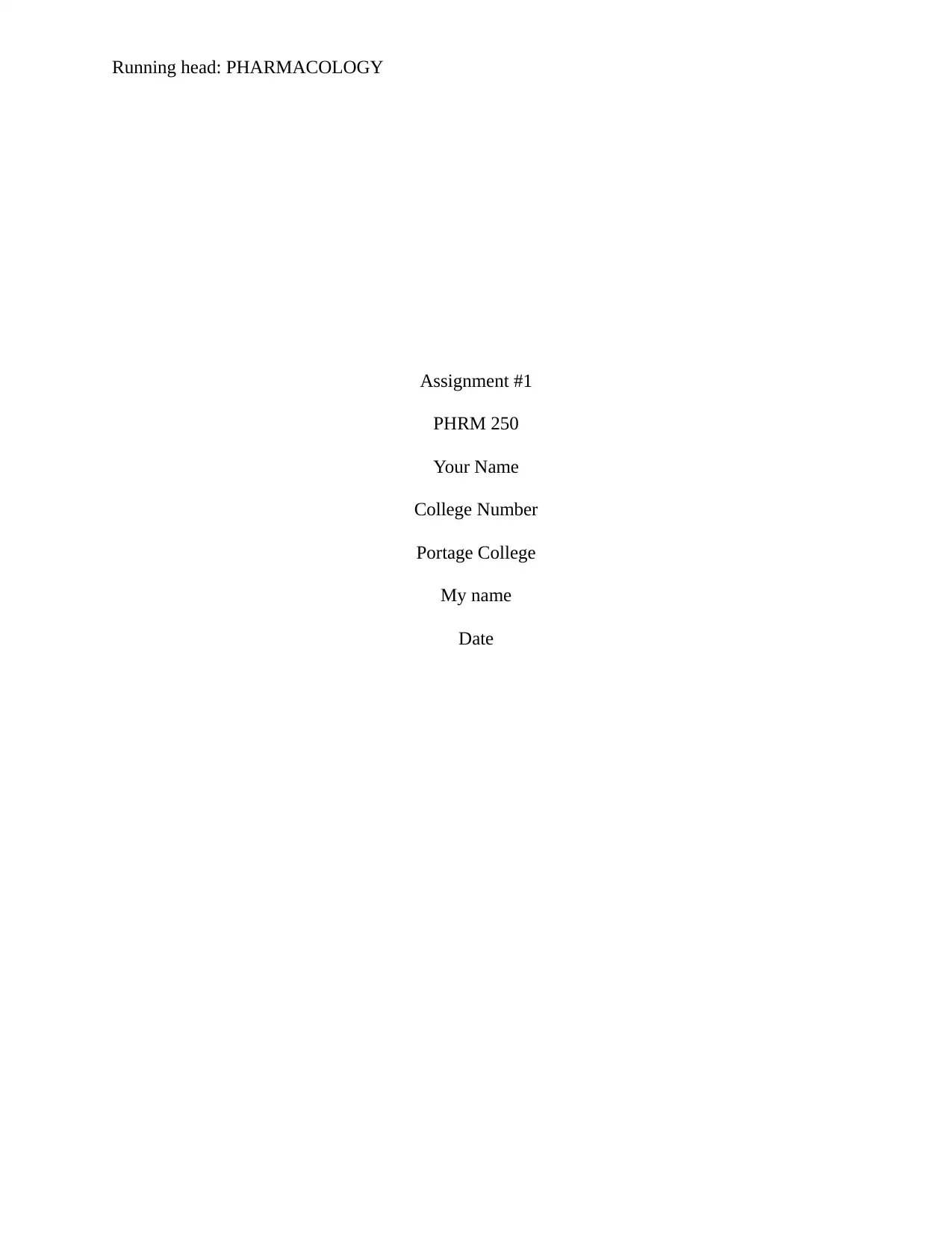
Running head: PHARMACOLOGY
Assignment #1
PHRM 250
Your Name
College Number
Portage College
My name
Date
Assignment #1
PHRM 250
Your Name
College Number
Portage College
My name
Date
Paraphrase This Document
Need a fresh take? Get an instant paraphrase of this document with our AI Paraphraser
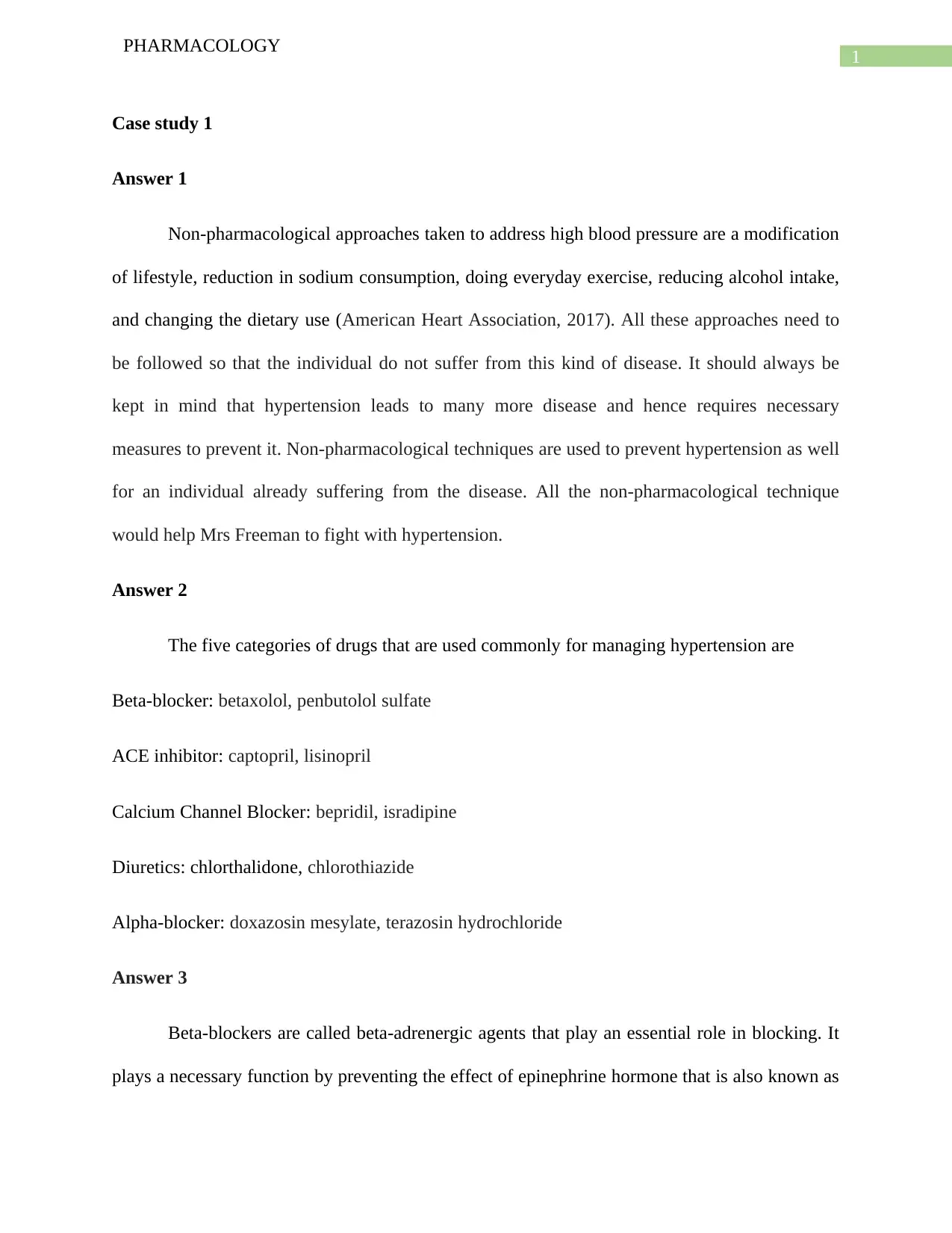
1
PHARMACOLOGY
Case study 1
Answer 1
Non-pharmacological approaches taken to address high blood pressure are a modification
of lifestyle, reduction in sodium consumption, doing everyday exercise, reducing alcohol intake,
and changing the dietary use (American Heart Association, 2017). All these approaches need to
be followed so that the individual do not suffer from this kind of disease. It should always be
kept in mind that hypertension leads to many more disease and hence requires necessary
measures to prevent it. Non-pharmacological techniques are used to prevent hypertension as well
for an individual already suffering from the disease. All the non-pharmacological technique
would help Mrs Freeman to fight with hypertension.
Answer 2
The five categories of drugs that are used commonly for managing hypertension are
Beta-blocker: betaxolol, penbutolol sulfate
ACE inhibitor: captopril, lisinopril
Calcium Channel Blocker: bepridil, isradipine
Diuretics: chlorthalidone, chlorothiazide
Alpha-blocker: doxazosin mesylate, terazosin hydrochloride
Answer 3
Beta-blockers are called beta-adrenergic agents that play an essential role in blocking. It
plays a necessary function by preventing the effect of epinephrine hormone that is also known as
PHARMACOLOGY
Case study 1
Answer 1
Non-pharmacological approaches taken to address high blood pressure are a modification
of lifestyle, reduction in sodium consumption, doing everyday exercise, reducing alcohol intake,
and changing the dietary use (American Heart Association, 2017). All these approaches need to
be followed so that the individual do not suffer from this kind of disease. It should always be
kept in mind that hypertension leads to many more disease and hence requires necessary
measures to prevent it. Non-pharmacological techniques are used to prevent hypertension as well
for an individual already suffering from the disease. All the non-pharmacological technique
would help Mrs Freeman to fight with hypertension.
Answer 2
The five categories of drugs that are used commonly for managing hypertension are
Beta-blocker: betaxolol, penbutolol sulfate
ACE inhibitor: captopril, lisinopril
Calcium Channel Blocker: bepridil, isradipine
Diuretics: chlorthalidone, chlorothiazide
Alpha-blocker: doxazosin mesylate, terazosin hydrochloride
Answer 3
Beta-blockers are called beta-adrenergic agents that play an essential role in blocking. It
plays a necessary function by preventing the effect of epinephrine hormone that is also known as
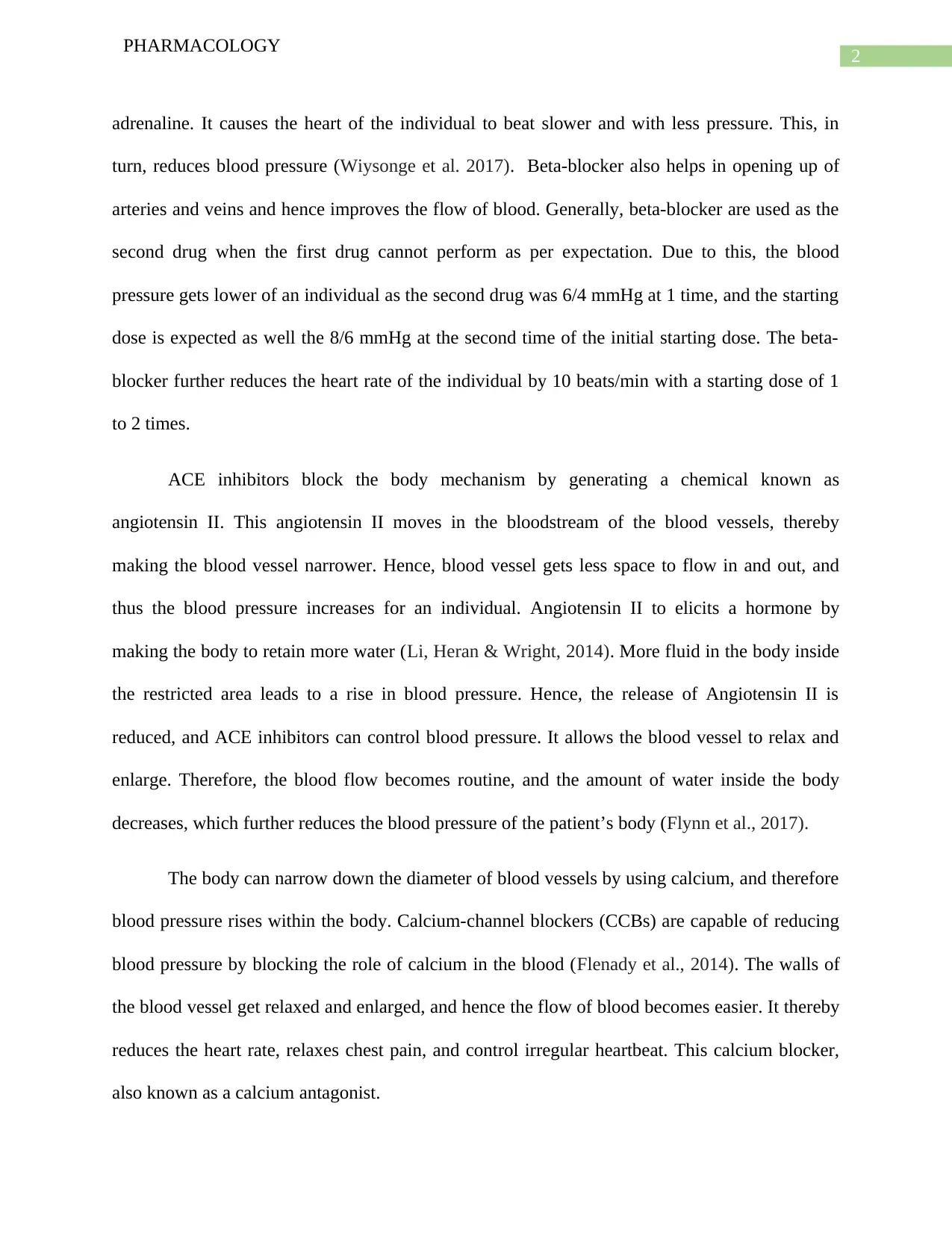
2
PHARMACOLOGY
adrenaline. It causes the heart of the individual to beat slower and with less pressure. This, in
turn, reduces blood pressure (Wiysonge et al. 2017). Beta-blocker also helps in opening up of
arteries and veins and hence improves the flow of blood. Generally, beta-blocker are used as the
second drug when the first drug cannot perform as per expectation. Due to this, the blood
pressure gets lower of an individual as the second drug was 6/4 mmHg at 1 time, and the starting
dose is expected as well the 8/6 mmHg at the second time of the initial starting dose. The beta-
blocker further reduces the heart rate of the individual by 10 beats/min with a starting dose of 1
to 2 times.
ACE inhibitors block the body mechanism by generating a chemical known as
angiotensin II. This angiotensin II moves in the bloodstream of the blood vessels, thereby
making the blood vessel narrower. Hence, blood vessel gets less space to flow in and out, and
thus the blood pressure increases for an individual. Angiotensin II to elicits a hormone by
making the body to retain more water (Li, Heran & Wright, 2014). More fluid in the body inside
the restricted area leads to a rise in blood pressure. Hence, the release of Angiotensin II is
reduced, and ACE inhibitors can control blood pressure. It allows the blood vessel to relax and
enlarge. Therefore, the blood flow becomes routine, and the amount of water inside the body
decreases, which further reduces the blood pressure of the patient’s body (Flynn et al., 2017).
The body can narrow down the diameter of blood vessels by using calcium, and therefore
blood pressure rises within the body. Calcium-channel blockers (CCBs) are capable of reducing
blood pressure by blocking the role of calcium in the blood (Flenady et al., 2014). The walls of
the blood vessel get relaxed and enlarged, and hence the flow of blood becomes easier. It thereby
reduces the heart rate, relaxes chest pain, and control irregular heartbeat. This calcium blocker,
also known as a calcium antagonist.
PHARMACOLOGY
adrenaline. It causes the heart of the individual to beat slower and with less pressure. This, in
turn, reduces blood pressure (Wiysonge et al. 2017). Beta-blocker also helps in opening up of
arteries and veins and hence improves the flow of blood. Generally, beta-blocker are used as the
second drug when the first drug cannot perform as per expectation. Due to this, the blood
pressure gets lower of an individual as the second drug was 6/4 mmHg at 1 time, and the starting
dose is expected as well the 8/6 mmHg at the second time of the initial starting dose. The beta-
blocker further reduces the heart rate of the individual by 10 beats/min with a starting dose of 1
to 2 times.
ACE inhibitors block the body mechanism by generating a chemical known as
angiotensin II. This angiotensin II moves in the bloodstream of the blood vessels, thereby
making the blood vessel narrower. Hence, blood vessel gets less space to flow in and out, and
thus the blood pressure increases for an individual. Angiotensin II to elicits a hormone by
making the body to retain more water (Li, Heran & Wright, 2014). More fluid in the body inside
the restricted area leads to a rise in blood pressure. Hence, the release of Angiotensin II is
reduced, and ACE inhibitors can control blood pressure. It allows the blood vessel to relax and
enlarge. Therefore, the blood flow becomes routine, and the amount of water inside the body
decreases, which further reduces the blood pressure of the patient’s body (Flynn et al., 2017).
The body can narrow down the diameter of blood vessels by using calcium, and therefore
blood pressure rises within the body. Calcium-channel blockers (CCBs) are capable of reducing
blood pressure by blocking the role of calcium in the blood (Flenady et al., 2014). The walls of
the blood vessel get relaxed and enlarged, and hence the flow of blood becomes easier. It thereby
reduces the heart rate, relaxes chest pain, and control irregular heartbeat. This calcium blocker,
also known as a calcium antagonist.
⊘ This is a preview!⊘
Do you want full access?
Subscribe today to unlock all pages.

Trusted by 1+ million students worldwide

3
PHARMACOLOGY
PHARMACOLOGY
Paraphrase This Document
Need a fresh take? Get an instant paraphrase of this document with our AI Paraphraser
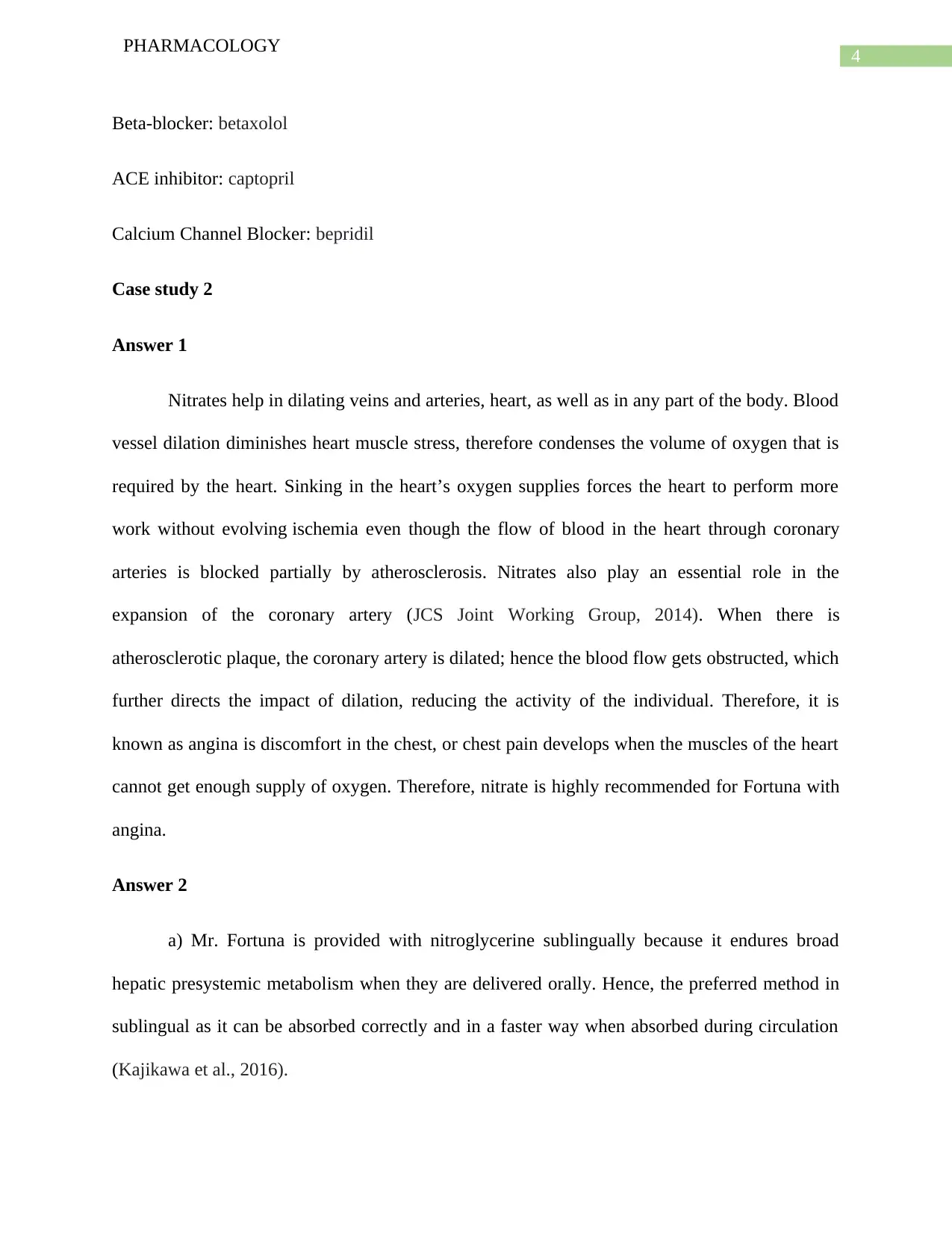
4
PHARMACOLOGY
Beta-blocker: betaxolol
ACE inhibitor: captopril
Calcium Channel Blocker: bepridil
Case study 2
Answer 1
Nitrates help in dilating veins and arteries, heart, as well as in any part of the body. Blood
vessel dilation diminishes heart muscle stress, therefore condenses the volume of oxygen that is
required by the heart. Sinking in the heart’s oxygen supplies forces the heart to perform more
work without evolving ischemia even though the flow of blood in the heart through coronary
arteries is blocked partially by atherosclerosis. Nitrates also play an essential role in the
expansion of the coronary artery (JCS Joint Working Group, 2014). When there is
atherosclerotic plaque, the coronary artery is dilated; hence the blood flow gets obstructed, which
further directs the impact of dilation, reducing the activity of the individual. Therefore, it is
known as angina is discomfort in the chest, or chest pain develops when the muscles of the heart
cannot get enough supply of oxygen. Therefore, nitrate is highly recommended for Fortuna with
angina.
Answer 2
a) Mr. Fortuna is provided with nitroglycerine sublingually because it endures broad
hepatic presystemic metabolism when they are delivered orally. Hence, the preferred method in
sublingual as it can be absorbed correctly and in a faster way when absorbed during circulation
(Kajikawa et al., 2016).
PHARMACOLOGY
Beta-blocker: betaxolol
ACE inhibitor: captopril
Calcium Channel Blocker: bepridil
Case study 2
Answer 1
Nitrates help in dilating veins and arteries, heart, as well as in any part of the body. Blood
vessel dilation diminishes heart muscle stress, therefore condenses the volume of oxygen that is
required by the heart. Sinking in the heart’s oxygen supplies forces the heart to perform more
work without evolving ischemia even though the flow of blood in the heart through coronary
arteries is blocked partially by atherosclerosis. Nitrates also play an essential role in the
expansion of the coronary artery (JCS Joint Working Group, 2014). When there is
atherosclerotic plaque, the coronary artery is dilated; hence the blood flow gets obstructed, which
further directs the impact of dilation, reducing the activity of the individual. Therefore, it is
known as angina is discomfort in the chest, or chest pain develops when the muscles of the heart
cannot get enough supply of oxygen. Therefore, nitrate is highly recommended for Fortuna with
angina.
Answer 2
a) Mr. Fortuna is provided with nitroglycerine sublingually because it endures broad
hepatic presystemic metabolism when they are delivered orally. Hence, the preferred method in
sublingual as it can be absorbed correctly and in a faster way when absorbed during circulation
(Kajikawa et al., 2016).
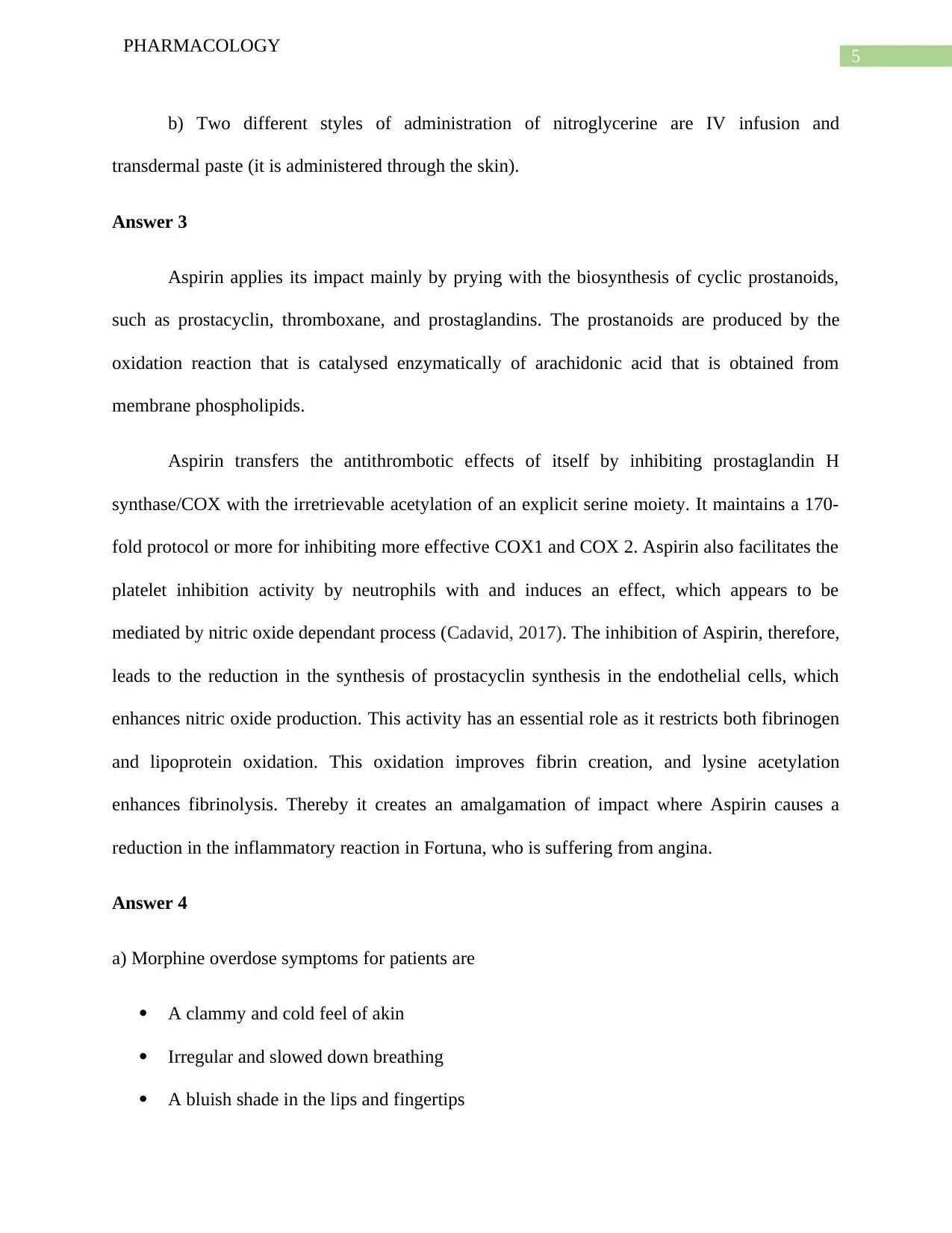
5
PHARMACOLOGY
b) Two different styles of administration of nitroglycerine are IV infusion and
transdermal paste (it is administered through the skin).
Answer 3
Aspirin applies its impact mainly by prying with the biosynthesis of cyclic prostanoids,
such as prostacyclin, thromboxane, and prostaglandins. The prostanoids are produced by the
oxidation reaction that is catalysed enzymatically of arachidonic acid that is obtained from
membrane phospholipids.
Aspirin transfers the antithrombotic effects of itself by inhibiting prostaglandin H
synthase/COX with the irretrievable acetylation of an explicit serine moiety. It maintains a 170-
fold protocol or more for inhibiting more effective COX1 and COX 2. Aspirin also facilitates the
platelet inhibition activity by neutrophils with and induces an effect, which appears to be
mediated by nitric oxide dependant process (Cadavid, 2017). The inhibition of Aspirin, therefore,
leads to the reduction in the synthesis of prostacyclin synthesis in the endothelial cells, which
enhances nitric oxide production. This activity has an essential role as it restricts both fibrinogen
and lipoprotein oxidation. This oxidation improves fibrin creation, and lysine acetylation
enhances fibrinolysis. Thereby it creates an amalgamation of impact where Aspirin causes a
reduction in the inflammatory reaction in Fortuna, who is suffering from angina.
Answer 4
a) Morphine overdose symptoms for patients are
A clammy and cold feel of akin
Irregular and slowed down breathing
A bluish shade in the lips and fingertips
PHARMACOLOGY
b) Two different styles of administration of nitroglycerine are IV infusion and
transdermal paste (it is administered through the skin).
Answer 3
Aspirin applies its impact mainly by prying with the biosynthesis of cyclic prostanoids,
such as prostacyclin, thromboxane, and prostaglandins. The prostanoids are produced by the
oxidation reaction that is catalysed enzymatically of arachidonic acid that is obtained from
membrane phospholipids.
Aspirin transfers the antithrombotic effects of itself by inhibiting prostaglandin H
synthase/COX with the irretrievable acetylation of an explicit serine moiety. It maintains a 170-
fold protocol or more for inhibiting more effective COX1 and COX 2. Aspirin also facilitates the
platelet inhibition activity by neutrophils with and induces an effect, which appears to be
mediated by nitric oxide dependant process (Cadavid, 2017). The inhibition of Aspirin, therefore,
leads to the reduction in the synthesis of prostacyclin synthesis in the endothelial cells, which
enhances nitric oxide production. This activity has an essential role as it restricts both fibrinogen
and lipoprotein oxidation. This oxidation improves fibrin creation, and lysine acetylation
enhances fibrinolysis. Thereby it creates an amalgamation of impact where Aspirin causes a
reduction in the inflammatory reaction in Fortuna, who is suffering from angina.
Answer 4
a) Morphine overdose symptoms for patients are
A clammy and cold feel of akin
Irregular and slowed down breathing
A bluish shade in the lips and fingertips
⊘ This is a preview!⊘
Do you want full access?
Subscribe today to unlock all pages.

Trusted by 1+ million students worldwide
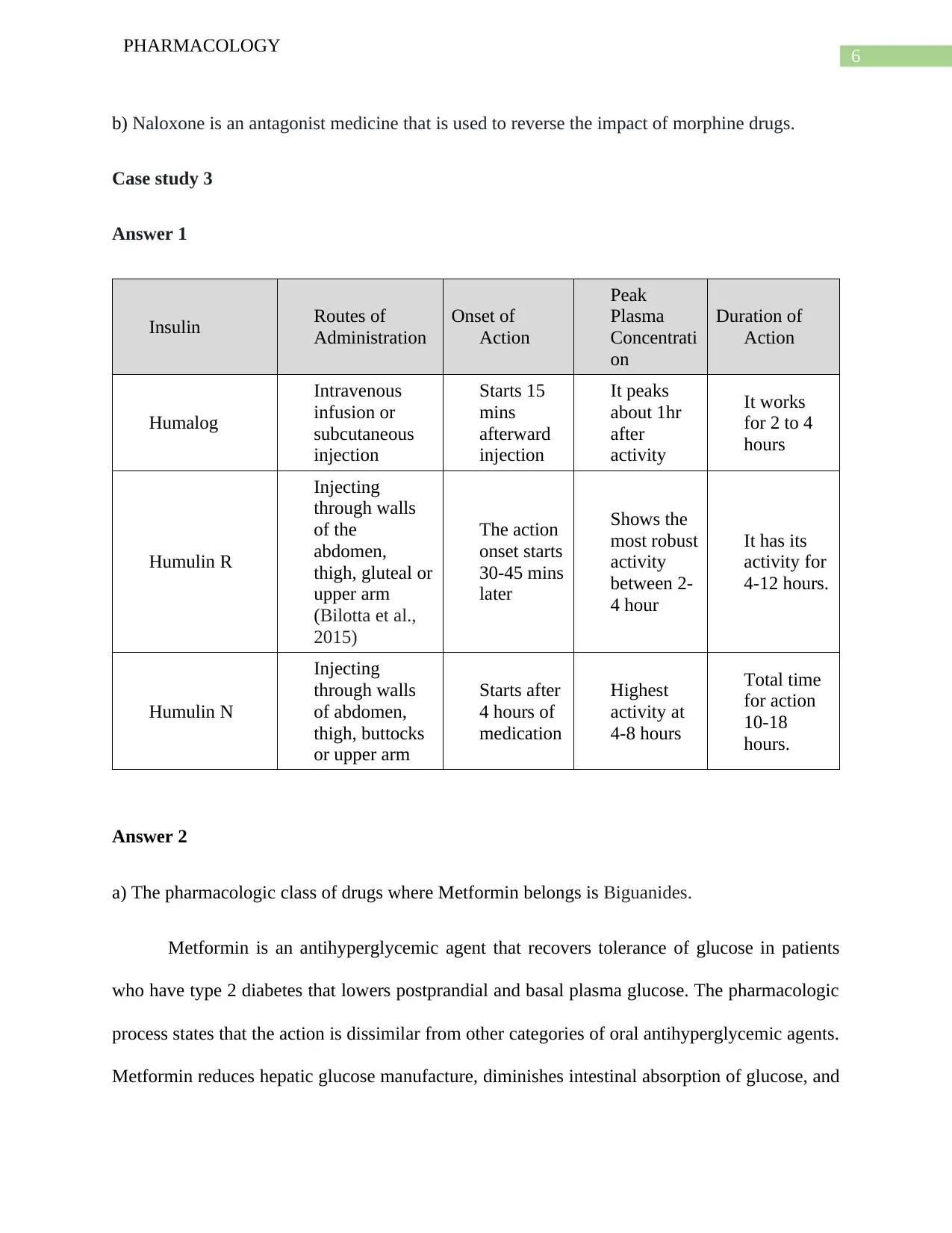
6
PHARMACOLOGY
b) Naloxone is an antagonist medicine that is used to reverse the impact of morphine drugs.
Case study 3
Answer 1
Insulin Routes of
Administration
Onset of
Action
Peak
Plasma
Concentrati
on
Duration of
Action
Humalog
Intravenous
infusion or
subcutaneous
injection
Starts 15
mins
afterward
injection
It peaks
about 1hr
after
activity
It works
for 2 to 4
hours
Humulin R
Injecting
through walls
of the
abdomen,
thigh, gluteal or
upper arm
(Bilotta et al.,
2015)
The action
onset starts
30-45 mins
later
Shows the
most robust
activity
between 2-
4 hour
It has its
activity for
4-12 hours.
Humulin N
Injecting
through walls
of abdomen,
thigh, buttocks
or upper arm
Starts after
4 hours of
medication
Highest
activity at
4-8 hours
Total time
for action
10-18
hours.
Answer 2
a) The pharmacologic class of drugs where Metformin belongs is Biguanides.
Metformin is an antihyperglycemic agent that recovers tolerance of glucose in patients
who have type 2 diabetes that lowers postprandial and basal plasma glucose. The pharmacologic
process states that the action is dissimilar from other categories of oral antihyperglycemic agents.
Metformin reduces hepatic glucose manufacture, diminishes intestinal absorption of glucose, and
PHARMACOLOGY
b) Naloxone is an antagonist medicine that is used to reverse the impact of morphine drugs.
Case study 3
Answer 1
Insulin Routes of
Administration
Onset of
Action
Peak
Plasma
Concentrati
on
Duration of
Action
Humalog
Intravenous
infusion or
subcutaneous
injection
Starts 15
mins
afterward
injection
It peaks
about 1hr
after
activity
It works
for 2 to 4
hours
Humulin R
Injecting
through walls
of the
abdomen,
thigh, gluteal or
upper arm
(Bilotta et al.,
2015)
The action
onset starts
30-45 mins
later
Shows the
most robust
activity
between 2-
4 hour
It has its
activity for
4-12 hours.
Humulin N
Injecting
through walls
of abdomen,
thigh, buttocks
or upper arm
Starts after
4 hours of
medication
Highest
activity at
4-8 hours
Total time
for action
10-18
hours.
Answer 2
a) The pharmacologic class of drugs where Metformin belongs is Biguanides.
Metformin is an antihyperglycemic agent that recovers tolerance of glucose in patients
who have type 2 diabetes that lowers postprandial and basal plasma glucose. The pharmacologic
process states that the action is dissimilar from other categories of oral antihyperglycemic agents.
Metformin reduces hepatic glucose manufacture, diminishes intestinal absorption of glucose, and
Paraphrase This Document
Need a fresh take? Get an instant paraphrase of this document with our AI Paraphraser
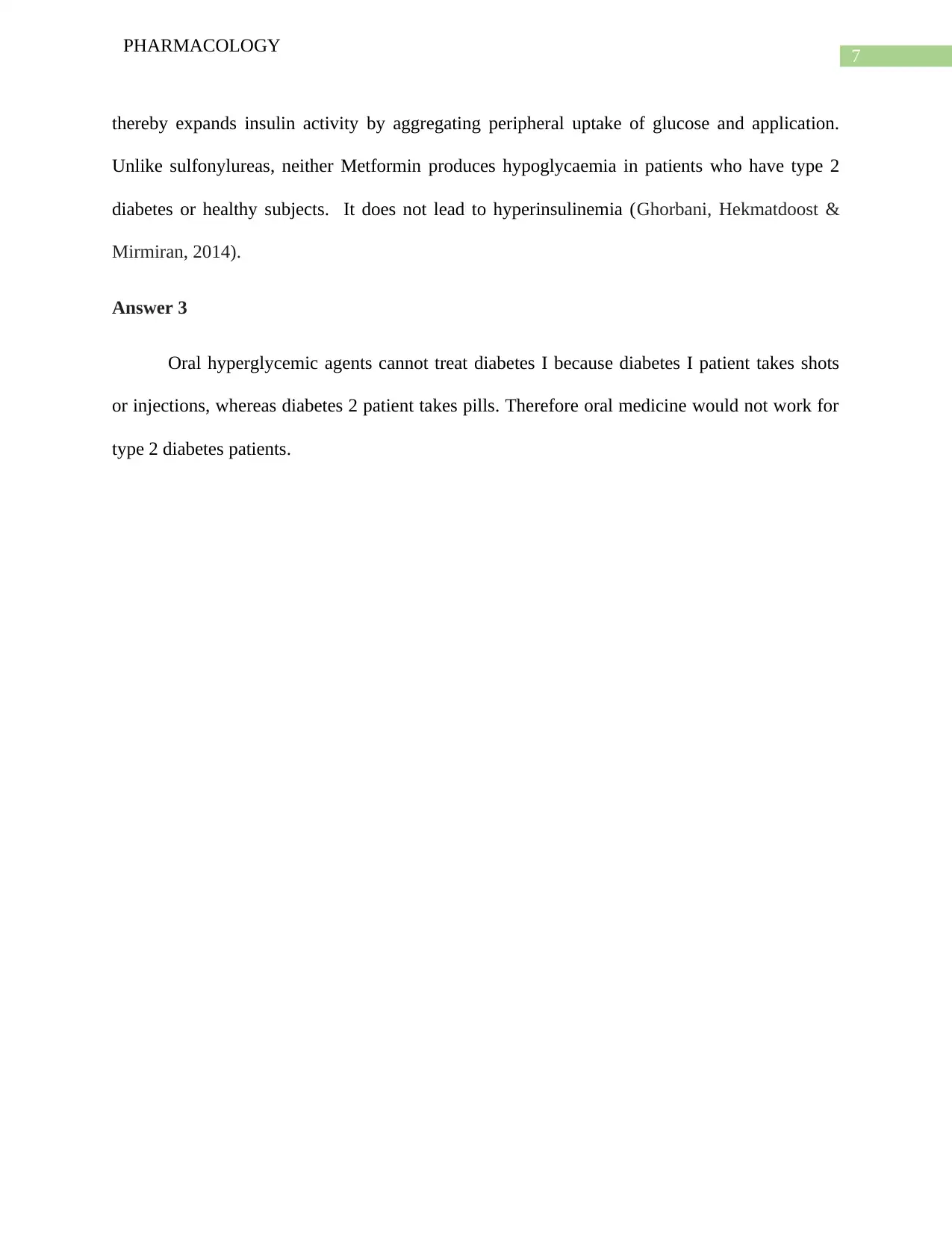
7
PHARMACOLOGY
thereby expands insulin activity by aggregating peripheral uptake of glucose and application.
Unlike sulfonylureas, neither Metformin produces hypoglycaemia in patients who have type 2
diabetes or healthy subjects. It does not lead to hyperinsulinemia (Ghorbani, Hekmatdoost &
Mirmiran, 2014).
Answer 3
Oral hyperglycemic agents cannot treat diabetes I because diabetes I patient takes shots
or injections, whereas diabetes 2 patient takes pills. Therefore oral medicine would not work for
type 2 diabetes patients.
PHARMACOLOGY
thereby expands insulin activity by aggregating peripheral uptake of glucose and application.
Unlike sulfonylureas, neither Metformin produces hypoglycaemia in patients who have type 2
diabetes or healthy subjects. It does not lead to hyperinsulinemia (Ghorbani, Hekmatdoost &
Mirmiran, 2014).
Answer 3
Oral hyperglycemic agents cannot treat diabetes I because diabetes I patient takes shots
or injections, whereas diabetes 2 patient takes pills. Therefore oral medicine would not work for
type 2 diabetes patients.
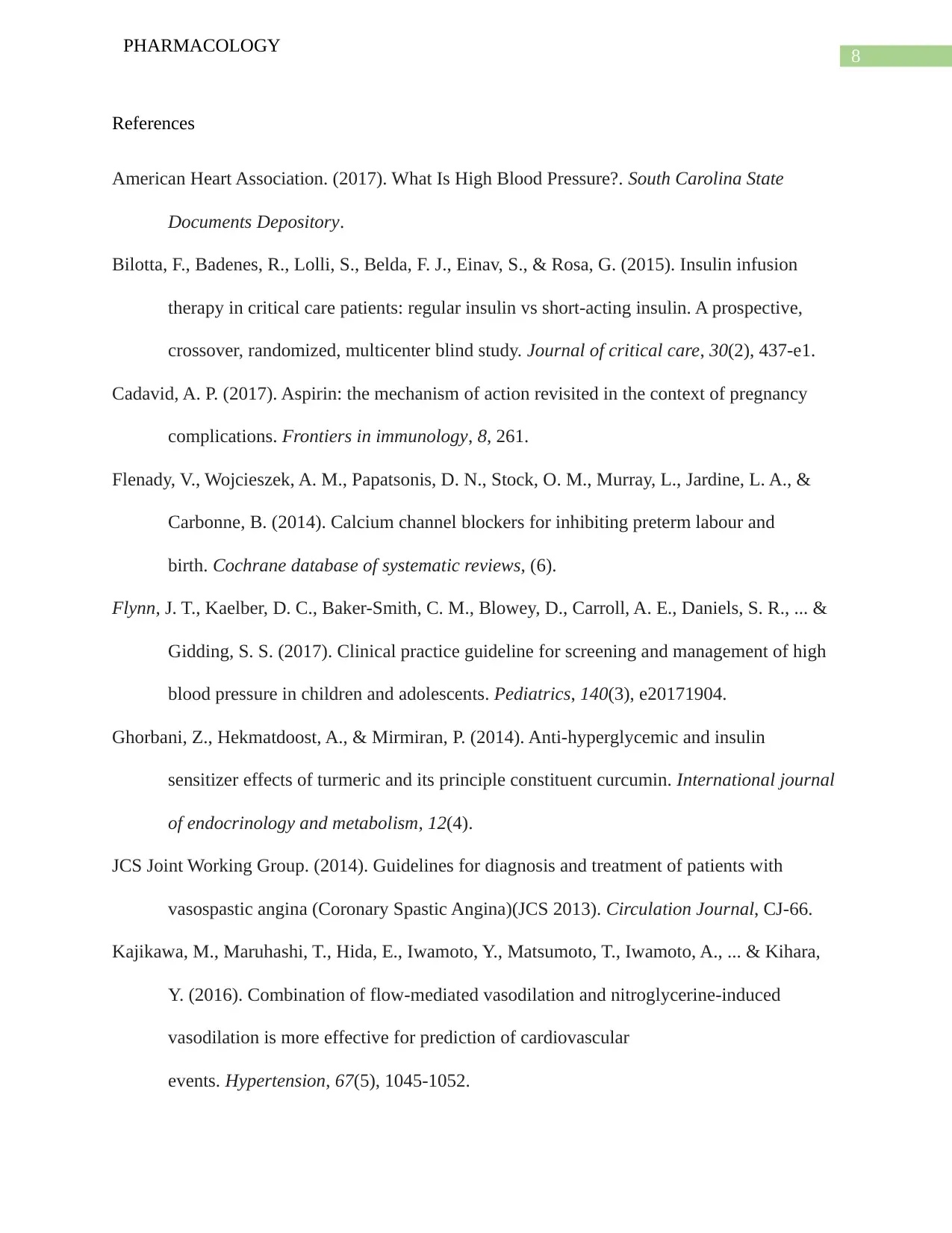
8
PHARMACOLOGY
References
American Heart Association. (2017). What Is High Blood Pressure?. South Carolina State
Documents Depository.
Bilotta, F., Badenes, R., Lolli, S., Belda, F. J., Einav, S., & Rosa, G. (2015). Insulin infusion
therapy in critical care patients: regular insulin vs short-acting insulin. A prospective,
crossover, randomized, multicenter blind study. Journal of critical care, 30(2), 437-e1.
Cadavid, A. P. (2017). Aspirin: the mechanism of action revisited in the context of pregnancy
complications. Frontiers in immunology, 8, 261.
Flenady, V., Wojcieszek, A. M., Papatsonis, D. N., Stock, O. M., Murray, L., Jardine, L. A., &
Carbonne, B. (2014). Calcium channel blockers for inhibiting preterm labour and
birth. Cochrane database of systematic reviews, (6).
Flynn, J. T., Kaelber, D. C., Baker-Smith, C. M., Blowey, D., Carroll, A. E., Daniels, S. R., ... &
Gidding, S. S. (2017). Clinical practice guideline for screening and management of high
blood pressure in children and adolescents. Pediatrics, 140(3), e20171904.
Ghorbani, Z., Hekmatdoost, A., & Mirmiran, P. (2014). Anti-hyperglycemic and insulin
sensitizer effects of turmeric and its principle constituent curcumin. International journal
of endocrinology and metabolism, 12(4).
JCS Joint Working Group. (2014). Guidelines for diagnosis and treatment of patients with
vasospastic angina (Coronary Spastic Angina)(JCS 2013). Circulation Journal, CJ-66.
Kajikawa, M., Maruhashi, T., Hida, E., Iwamoto, Y., Matsumoto, T., Iwamoto, A., ... & Kihara,
Y. (2016). Combination of flow-mediated vasodilation and nitroglycerine-induced
vasodilation is more effective for prediction of cardiovascular
events. Hypertension, 67(5), 1045-1052.
PHARMACOLOGY
References
American Heart Association. (2017). What Is High Blood Pressure?. South Carolina State
Documents Depository.
Bilotta, F., Badenes, R., Lolli, S., Belda, F. J., Einav, S., & Rosa, G. (2015). Insulin infusion
therapy in critical care patients: regular insulin vs short-acting insulin. A prospective,
crossover, randomized, multicenter blind study. Journal of critical care, 30(2), 437-e1.
Cadavid, A. P. (2017). Aspirin: the mechanism of action revisited in the context of pregnancy
complications. Frontiers in immunology, 8, 261.
Flenady, V., Wojcieszek, A. M., Papatsonis, D. N., Stock, O. M., Murray, L., Jardine, L. A., &
Carbonne, B. (2014). Calcium channel blockers for inhibiting preterm labour and
birth. Cochrane database of systematic reviews, (6).
Flynn, J. T., Kaelber, D. C., Baker-Smith, C. M., Blowey, D., Carroll, A. E., Daniels, S. R., ... &
Gidding, S. S. (2017). Clinical practice guideline for screening and management of high
blood pressure in children and adolescents. Pediatrics, 140(3), e20171904.
Ghorbani, Z., Hekmatdoost, A., & Mirmiran, P. (2014). Anti-hyperglycemic and insulin
sensitizer effects of turmeric and its principle constituent curcumin. International journal
of endocrinology and metabolism, 12(4).
JCS Joint Working Group. (2014). Guidelines for diagnosis and treatment of patients with
vasospastic angina (Coronary Spastic Angina)(JCS 2013). Circulation Journal, CJ-66.
Kajikawa, M., Maruhashi, T., Hida, E., Iwamoto, Y., Matsumoto, T., Iwamoto, A., ... & Kihara,
Y. (2016). Combination of flow-mediated vasodilation and nitroglycerine-induced
vasodilation is more effective for prediction of cardiovascular
events. Hypertension, 67(5), 1045-1052.
⊘ This is a preview!⊘
Do you want full access?
Subscribe today to unlock all pages.

Trusted by 1+ million students worldwide
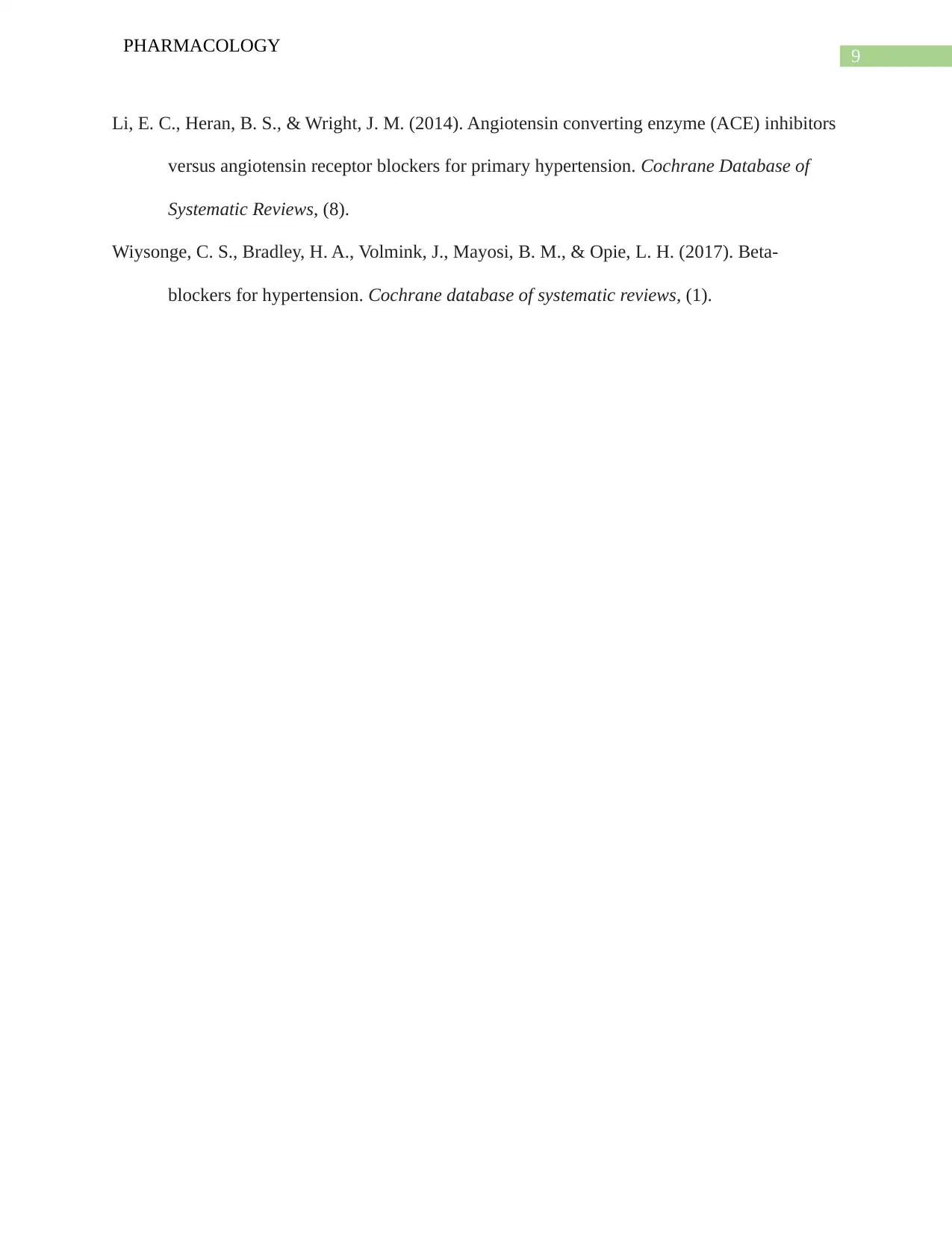
9
PHARMACOLOGY
Li, E. C., Heran, B. S., & Wright, J. M. (2014). Angiotensin converting enzyme (ACE) inhibitors
versus angiotensin receptor blockers for primary hypertension. Cochrane Database of
Systematic Reviews, (8).
Wiysonge, C. S., Bradley, H. A., Volmink, J., Mayosi, B. M., & Opie, L. H. (2017). Beta‐
blockers for hypertension. Cochrane database of systematic reviews, (1).
PHARMACOLOGY
Li, E. C., Heran, B. S., & Wright, J. M. (2014). Angiotensin converting enzyme (ACE) inhibitors
versus angiotensin receptor blockers for primary hypertension. Cochrane Database of
Systematic Reviews, (8).
Wiysonge, C. S., Bradley, H. A., Volmink, J., Mayosi, B. M., & Opie, L. H. (2017). Beta‐
blockers for hypertension. Cochrane database of systematic reviews, (1).
1 out of 10
Related Documents
Your All-in-One AI-Powered Toolkit for Academic Success.
+13062052269
info@desklib.com
Available 24*7 on WhatsApp / Email
![[object Object]](/_next/static/media/star-bottom.7253800d.svg)
Unlock your academic potential
Copyright © 2020–2025 A2Z Services. All Rights Reserved. Developed and managed by ZUCOL.





